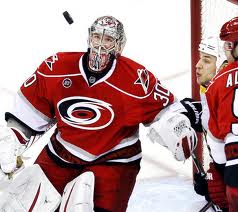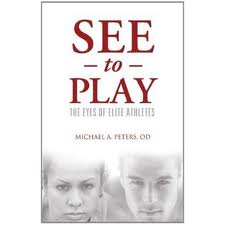About a month back I had the pleasure of reading a new book, See to Play: The Eyes of Advanced Athletes by Dr. Michael Peters, discussing the role of the visual system in athletics, as well as some easy at-home assessment and training techniques to assess specific visual qualities. I was really impressed with the content and user-friendly nature of the book. I strongly believe that a lot of players AND students have significant performance limitations based on visual limitations that are simply missed in traditional screening. I also believe that this information provides an alternative explanation to some of the postural, motor, and musculoskeletal issues we see commonly AND heavily influences symptoms and return to play times following a concussion. With all that said, I’m excited that I was able to get Dr. Peters to do an interview for us regarding the visual system and the role it plays and athletic performance. Without further adieu, Dr Peters…

Dr. Michael Peters
KN: Dr. Peters, thank you so much for taking the time to do the interview. This is an important topic that many athletes aren’t very well informed about! Before we dive in, can you briefly tell us a bit about yourself?
MP: I am an optometrist who has been in private practice since 1988. I was an athlete that was weeded out at the college football level because I could not see to play. Contact lenses did not work for me and glasses did not work for me. I made it my life’s mission to make sure this wouldn’t happen to other athletes. Through my experience, it appears 4 out of 10 athletes don’t make it to the professional level because of something wrong with their visual system.

Cam Ward demonstrating the importance of a well-tuned visual system.
I’ve been the team eye doctor for the Carolina Hurricanes since they moved from Hartford in 1997. I’m the team eye doctor for the Durham Bulls (AAA Tampa Rays), USA National Baseball Team, the Carolina Mudcats (A Cleveland Indians) and Carolina Rail Hawks. I’ve worked with athletes in the NFL, MLB, NBA, NHL and MLS.
KN: Given your experience working with NHL players, can you explain the role the visual system plays in hockey performance?
MP: Hockey is one of the fastest and potentially dangerous sports for our body. Our eyes are our first line defense from injury. Our bodies fight and flight mechanism is on high alert and this is the first role of vision. This is why learning proper gaze control is important. Hockey players need to use their peripheral vision to take in more and make sure that they are looking at the correct locations on the ice. Leaving you head on a swivel means you’re prone to looking at one place too long and you’re going to get a bad hit. Ryan Murphy’s hit last year is a good example. Here is a link to see that hit:
In my book, See To Play, I discuss the detailed vision zone. In my opinion, this is the most important trait for hockey players. The athletes with larger zones see more of the ice, see more of the play developing and can react to where things need to be on the ice to make the play.

KN: Interesting. With all of that in mind, what limitations do you see commonly?
MP: Athletes choose to see less clear than their genetic potential allows them. Athletes overlook vision. They think they see “good enough”. The problem with that thinking is that elite athletes see the best! They’re vision is awesome. This is because of a physical trait that they were gifted with or they were smart enough to get to the eye doctor early and often. Maximizing visual acuity insures athletes are allowing their eye hand coordination to develop to its fullest potential
Another limitation I find is that athletes don’t use their complete area of vision. The detailed vision zone is the most important visual trait for hockey athletes and through vision training, athletes can insure they are maximizing their genetic potential and not allowing this zone to shrink due to disuse. Chapter 3 in my book, See To Play, is dedicated to this topic.
KN: What visual system qualities may be overlooked in a typical eye exam?
MP: During routine eye exams, eye doctors test for visual acuity and eye health. We don’t normally test for an athlete’s detailed vision zone, their speed of focus and perception. Separate exams, known as sports vision exams, provide this extra testing to help fully evaluate athlete’s visual system.
KN: That has certainly been my experience. None of the youth and college athletes I’ve talked to are even aware that this type of testing is out there. It’s a shame given how crucial it is to their success.
Last, but certainly not least, what role does the visual system play in returning from injuries like concussions?
MP: The eyes take a picture and send it back to the brain to decipher it. Concussions can affect the part of the brain that is in charge of figuring out the picture the eyes have taken. Athletes with visual issues in their concussions will complain of blurred vision, dizziness, light sensitivity, decreased concentration, anxiety when walking into a crowd of people and motion sickness when driving or riding in a car.
Usually, these visual issues resolve with rest. For the athletes with lingering symptoms, we use vision training to help speed up recovery.
“I had a wonderful experience working with Dr. Peters while recovering from my concussion. His techniques are cutting edge and results-driven based on his professional experience with countless athletes. Dr. Peters’ ability to interpret and diagnose visual symptoms, along with the capacity to objectively measure one’s progress in recovering from those symptoms makes consulting Dr. Peters a priority for any brain injury.
How concussions can affect the visual system, and how the visual system interacts with cognitive and vestibular functions during concussion recovery is just beginning to be understood. Dr. Peters is no doubt a leader in that research and a developer of new therapeutic techniques based on its findings. As a professional athlete, and having recently recovered from concussion, I would consider any treatment plan that does not include dorsal stream visual therapy as incomplete.” – Jay Harrison, Carolina Hurricanes
KN: Dr. Peters, thank you for taking the time to provide some insight into the importance of the visual system. We greatly appreciate it!
For more information, check out SeeToPlay.com!
To your success,
Kevin Neeld
P.S. Pick up a copy of See To Play and try out the visual assessments at home!
Please enter your first name and email below to sign up for my FREE Athletic Development and Hockey Training Newsletter!